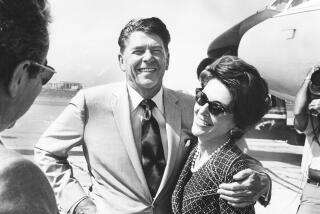From the Archives: ‘The Waxman Report: How Congress Really Works’ by Henry Waxman with Joshua Green
Pretty faces and promising careers tend to flash across our local political firmament with the frequency of shooting stars -- and with about as much effect. But for more than two decades, the most consequential elected official in Southern California has been a short, bald, decidedly mustached congressman from Los Angeles’ Westside named Henry Waxman.
In fact, when the history of postwar America is definitively written, it’s possible that the record will show that the three California politicians who had the biggest impact on the largest number of American lives were Earl Warren, as chief justice; Ronald Reagan, as president; and Henry Waxman as representative of the 30th District in the U.S. House of Representatives. Tens of millions of Americans are healthier, breathe cleaner air and live safer lives because of his legislative efforts. Among living lawmakers, his record of legislative achievement can be compared only to Sen. Ted Kennedy’s.
On that basis alone, “The Waxman Report: How Congress Really Works” would merit respectful attention. However, the congressman, now 69, has, along with his collaborator Joshua Green of the Atlantic magazine, produced something unexpected and rather fine. “The Waxman Report” is part compelling memoir, part fascinating, shrewd civics lesson and part bracing statement of practical idealism. It’s impossible to put down and a joy to read -- a model, in fact, of lucid exposition. If your plans for the long Independence Day weekend incline toward thoughts on the state of the nation, skip all the patriotic kitsch and read this book.
The timing is fortuitous, because Waxman is more than ever at the center of events, since the House Energy and Commerce Committee, which he chairs, shares jurisdiction over the energy and healthcare issues key to President Obama’s agenda. The Westside Democrat and Rep. George Miller, a longtime friend and Riverside County Democrat who chairs the Education and Labor Committee, and Rep. Charles B. Rangel, the New York Democrat who heads Ways and Means, have agreed to work together -- their committees have jurisdiction over healthcare -- to produce a single House healthcare measure. (Miller, Waxman and Minnesota’s James L. Oberstar are the only surviving Democratic representatives elected as members of 1974’s so-called reform class.) Moreover, Phil Schiliro, who was Waxman’s chief of staff for 27 years, now is Obama’s congressional liaison. (Read this book and you’ll understand the importance of such connections.)
Waxman’s tenacity as an investigator and questioner are storied. When he became chairman of the House Committee on Oversight and Government Reform in 2007, a Time magazine profile -- while noting that he stands less than 5 1/2 feet tall -- called him “the scariest guy in town.” As a result of rule changes pushed through by the Republicans during their futile pursuit of Bill Clinton, the chairman of that committee is the only one in Congress with the unilateral power to issue subpoenas. Waxman, the profile pointed out, assumed the chairmanship noting that while the House compelled 140 hours of sworn testimony over allegations that Clinton had used the White House Christmas-card list for political purposes, it had questioned witnesses for just 12 hours over the abuse of prisoners at Abu Ghraib prison.
Though always prepared to reach across the aisle for allies, Waxman is legendarily tough. His friend Miller once said that when he first came to the House, “I thought Henry’s first name was ‘sonofabitch.’ Everybody . . . kept saying, ‘Do you know what that sonofabitch Waxman wants?’ ”
One of the pleasures of “The Waxman Report” is tracing the origins of these signature traits to his Los Angeles boyhood. Waxman was born in Boyle Heights. His parents’ families had emigrated from Bessarabia (contemporary Moldova) to escape the pogroms. The neighborhood in those days “was a teeming immigrant community with a heavy representation of Russian and Eastern European Jews, along with Mexicans, Japanese and many others.” His father was then a grocery clerk, a proud member of the Retail Clerks Union, Local 770, and -- like his mother -- a fervent supporter of Franklin D. Roosevelt and his New Deal. Waxman’s uncle, Al, was the founder and publisher of what was then the city’s important liberal newspaper, the East Side Journal, one of the few papers in the country to oppose internment of Japanese Americans and a voice of sanity during the Zoot Suit riots. Al Waxman also was one of the city’s first crusaders against smog.
After the war, L.A.’s Jewish community moved west to the Fairfax district and so did the Waxmans. Al’s paper became the L.A. Reporter (often known in those days as “the Waxman Reporter”) and Henry’s father acquired a store in Watts, over which the family lived. Henry graduated from UCLA and UCLA Law School, but his passion was the school’s Young Democratic Club, through which he made lifelong friends and comrades like Phil and John Burton, Willie Brown and, most of all, Howard and Michael Berman. Howard, of course, has become his closest legislative colleague and now chairs the House Foreign Affairs Committee and watches the back of the Westside’s entertainment industry on intellectual property issues.
Waxman’s account of his first run for the state Assembly is pivotal to understanding his career because it taught him the value of tireless organizing and meticulous preparation. Even though his uncle’s widow refused him the L.A. Reporter’s endorsement -- the paper always had supported his opponent in the Democratic primary, a longtime incumbent -- Waxman carried the day, in part, by securing the endorsement of dapper Col. Leon Washington, publisher of the Los Angeles Sentinel, the city’s leading African American weekly.
Waxman’s chronicle of his education in L.A. and Sacramento politics is, if anything, too brief; his account of his congressional career is fascinatingly detailed, filled with blunt behind-the-scenes anecdotes and crisply drawn portraits of allies and opponents.
Most of all, it’s a detailed inside account of just how the nation’s laws are made. It succeeds as storytelling because Waxman and Green have structured most of the book as a series of narrative examples built around major bills. Thus chapters are titled, for instance, “HIV/AIDS and the Ryan White Act,” “The Orphan Drug Act,” “The Clean Air Act” and “The Tobacco Wars.” There’s a fascinating chapter on baseball and steroids as well.
Most of all, there’s a persuasive declaration of faith in that particular brand of liberalism that the late Arthur Schlesinger called “the politics of remedy.” As Waxman puts it, “In Boyle Heights, everyone thought of government as an institution that helped people.”
As this heartfelt, important little book will remind its readers, there’s a lot to be said for the faith of our fathers.
More to Read
The biggest entertainment stories
Get our big stories about Hollywood, film, television, music, arts, culture and more right in your inbox as soon as they publish.
You may occasionally receive promotional content from the Los Angeles Times.










